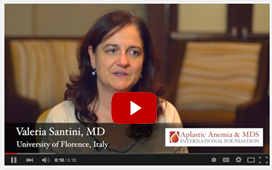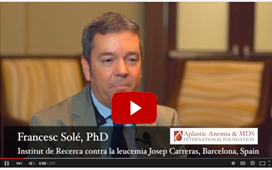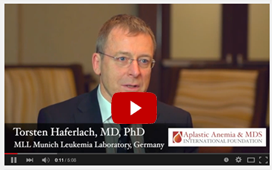The 2014 ASH Satellite Symposium on MDS and MDS/MPN: Past, Present, and Future was held Friday, December 5, 2014, in San Francisco, California. The symposium focused on myelodysplastic syndromes (MDS) and the overlap disease myelodysplastic syndromes/myeloproliferative neoplasms (MDS/MPN). The goal of this symposium was to bring together leaders in disease research and clinical practice to review the contributions of cytogentics and molecular genetics to the biology of these disorders. This symposium drew an international audience of more than 450 medical oncologists, hematologists, clinical and translational researchers, and other physicians and allied health care professionals treating patients with MDS and other bone marrow failure diseases.
As a service to patients and their families, AA&MDSIF recorded interviews with leading experts who presented sessions at the symposium. They explain the most important new research on MDS and MDS/MPN overlap syndromes. In addition, a lay language summary of their presentations is also available.
Watch these interviews on our YouTube channel:
 |
Valeria Santini, MD, University of Florence Dr. Santini presented on Bridging the Overlap Gap: Understanding the Natural History of Myelodysplastic/ Myeloproliferative Neoplasm (MDS/MPN). Different types of MDS/MPN have similar symptoms but profoundly different outcomes. The type and intensity of treatment must be tailored to each patient’s type of MDS/MPN. Therefore, it is important to diagnose these diseases accurately. |
 |
Francesc Solé, PhD, Institut de Recerca contra la leucemia Dr.Solé’s presentation was titled There is Always Room for Improvement: Changing Role of Chromosome Analysis in MDS and MDS/MPN. Conventional cytogenetics is a method to analyze chromosomes. Researchers and clinicians use conventional cytogenetics to diagnose blood disorders, predict outcomes in patients with these disorders, and develop new treatments that target genetic changes associated with a disease. |
 |
Torsten Haferlach, MD, PhD, MLL Munich Leukemia Laboratory Dr. Haferlach’s topic was Drivers or Passengers? Genetics of MDS and MDS/MPN Diagnosis of MDS or MDS/MPN must begin with morphology (analysis of the form and structure of patient blood or bone marrow cells). When used alone, today’s advanced techniques to study genes and chromosomes don’t give enough information to find out what type of MDS or MDS/MPN a patient has. But genetic information is critical for predicting a patient’s outcomes, guiding treatment decisions, and finding out whether a treatment has eliminated malignant cells. |
 |
Elias Jabbour, MD, University of Texas MD Anderson Cancer Center Dr. Jabbour presented Suffering from an Identity Crisis: Medications and Measures of Treatment Response in MDS/MPN. Advances in treatment for MDS/MPN are not keeping pace with the rapid improvement in understanding of the genetics of these diseases. Too little is known about how to treat these patients. |
 |
Hetty Carraway, MD, MBA, Cleveland Clinic Taussig Cancer Institute Dr. Carraway discussed Treatment Failures in MDS: Explanations and Options. In patients with MDS, a biochemical process known as methylation changes DNA’s ability to express genes (use the information in genes to control protein formation). The hypomethylating agents (HMAs) azacitidine (Vidaza®) and decitabine (Dacogen®) inhibit DNA methylation so that DNA sequences can act normally (re-express silenced genes). But some patients with MDS don’t respond to HMAs, and most patients who do respond eventually have a relapse. |
 |
Betty Ky Hamilton, MD, Cleveland Clinic Taussig Cancer Institute Dr. Hamilton’s presentation asked the question Can We Cure Them? The Role of Hematopoietic Stem Cell Transplantation in MDS/MPN. Treatments for MDS/MPN are typically “borrowed” from MDS or MPN because there’s no evidence on the effectiveness of treatments for MDS/MPN. The Food and Drug Administration has not approved any treatments specifically for MDS/MPN. |
 |
Ramon V. Tiu, MD, Cleveland Clinic Taussig Cancer Institute Dr. Tiu provided an overall synopsis of the symposium. Myelodysplastic/myeloproliferative neoplasm (MDS/MPN) is a disease of the blood and bone marrow. MDS/MPN has features of myeloproliferative diseases, such as too many white blood cells. The disease also has features of MDS, such as formation by the bone marrow of abnormal young white blood cells, known as blasts, that interfere with the development of healthy blood cells. The World Health Organization has classified MDS/MPN into the following categories: •Chronic myelomonocytic leukemia (CMML)—bone marrow makes too many white blood cells that fight infection, crowding out red blood cells and platelets •Juvenile myelomonocytic leukemia (JMML)—similar to CMML, except that it typically affects young children •Atypical chronic myelogenous leukemia (aCML)—bone marrow makes too many abnormal white blood cells, crowding out red blood cells and platelets •MDS/MPN neoplasm, unclassifiable—features of MDS and myeloproliferative diseases but is not CHMML, JMML, or aCML; includes the provisional category of refractory anemia with ringed sideroblasts associated with marked thrombocytosis MDS/MPN is difficult to diagnose. The U.S. Food and Drug Administration hasn’t approved any treatments specifically for MDS/MPN. |
Additional resources for patients:
- Interviews with our experts attending the ASH Annual Meeting in San Francisco to explain the most important new research on aplastic anemia, MDS and PNH. These physicians are AA&MDSIF Medical Advisory Board members or AA&MDSIF research grant recipients who shared their time and expertise to discuss the latest advances in bone marrow failure disease research.
- Lay language summaries for aplastic anemia
- PNH Studies Summary Report: International PNH Interest Group Meeting ASH 2014
- A Summary of Selected Scientific Abstracts for Patients with Myelodysplastic Syndromes (MDS) and their Caregivers


